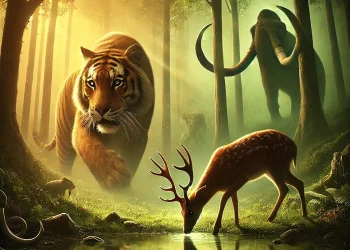SSLC English Question and Answer: The Tiger And The Deer
Looking for SSLC English Studies textbook answers? You can download Chapter 2: The Tiger and the Deer Questions and Answers PDF, Notes, and Summary here. SSLC English 3rd Language solutions follow the Karnataka State Board Syllabus, making it easier for students to revise and score higher in exams.
Karnataka SSLC 3rd Language English Textbook Answers—Reflections Poem 2
The Tiger and the Deer Questions and Answers, Notes, and Summary
Class 10 3rd Language English Poem 2
The Tiger And The Deer
Scroll Down to Download The Tiger and the Deer PDF
Comprehension I: The Tiger and The Deer
Question 1.
What does the poet compare ‘The Tiger and the deer’ to in this poem?
Answer:
The poet compares the tiger to strong, cruel beauty and the deer to mild, harmless beauty in nature.
Question 2.
How does the tiger attack its prey?
Answer:
The tiger crouches and creeps noiselessly through the forest. It suddenly leaps upon the deer when it is drinking water, catching it off guard.
Question 3.
What does the tiger stand for in this poem?
Answer:
The tiger stands for power, cruelty, and the merciless force of nature.
Question 4.
According to the poet, what does the deer remember at the time of death?
Answer:
At the time of death, the deer remembers its mate that it left behind in the deep woodland.
Question 5.
Pick out the words used by the poet to describe the nature of the tiger.
Answer:
The poet uses the words “brilliant,” “crouching,” “slouching,” “gleaming eyes,” “mighty chest,” “soft soundless paws,” and “pitiless splendour” to describe the tiger.
Question 6.
According to the poet, what would happen to the mighty and weak in the future?
Answer:
The poet suggests that a day will come when the mighty tiger will no longer crouch and leap in the forest, just as the mammoth no longer roams the plains of Asia. The mighty will perish, but the slain (the weak) will survive through their kind.
B. Dictionary work: The Tiger and The Deer
Sit in pairs, refer the dictionary and find out the meaning of the following words.
Crouching, slouching, grandeur, mammoth, slain
- Crouching:
- Meaning: Bending the body close to the ground with knees bent, often in a defensive or stealthy position.
- Example: The tiger was crouching in the bushes, ready to pounce.
- Slouching:
- Meaning: Standing, sitting, or walking with a drooping posture.
- Example: He was slouching in his chair out of boredom.
- Grandeur:
- Meaning: Splendid or impressive beauty, magnificence.
- Example: The grandeur of the palace left everyone in awe.
- Mammoth:
- Meaning: A large, extinct, elephant-like animal OR something enormous in size.
- Example: The mammoth roamed the plains thousands of years ago.
- Slain:
- Meaning: Killed violently or in battle.
- Example: The slain soldier was honored for his bravery.
Additional Questions and Answers: The Tiger and The Deer
Question 1.
What is the setting of the poem?
Answer:
The poem is set in a dense forest where the tiger prowls and the deer drinks from a cool, shadowy pool.
Question 2.
How does the poet describe the tiger’s movement?
Answer:
The poet describes the tiger’s movement as crouching, slouching, and creeping noiselessly through the forest with soft, soundless paws, making it a stealthy predator.
Question 3.
What emotion does the wind display in the poem?
Answer:
The wind seems fearful and cautious, slipping through the leaves silently, as if afraid of disturbing the tiger’s deadly presence.
Question 4.
What does the poet mean by “the slain survive the slayer”?
Answer:
This line suggests that while the mighty predator (the tiger) will eventually perish, the prey (the deer) will survive through its species, symbolizing the enduring nature of innocence over cruelty.
Question 5.
What is the central theme of the poem?
Answer:
The central theme of the poem is the inevitability of nature’s cycle of life and death. It also highlights the contrast between strength and gentleness, suggesting that even the mighty will eventually fall, but the gentle and meek will endure through their legacy.
Question 6.
What poetic devices are used in the poem?
Answer:
The poet uses imagery (e.g., “gleaming eyes and mighty chest”), alliteration (e.g., “crouched and crept”), and personification (e.g., “the wind slipped through the leaves as if afraid”) to enhance the vividness and emotion of the poem.
Question 7
What message does the poet convey about nature’s balance?
Answer:
The poet conveys that nature is both beautiful and brutal. Though the strong may dominate for a time, they will eventually perish, while the weak will continue to live on through their descendants, symbolizing the balance of nature.
About the poet : Sri Aurobindo
Sri Aurobindo, Indian nationalist, poet, philosopher and spiritual guru was born in Calcutta on 15th Aug, 1872. Sri Aurobindo spent his formative years in England studying at St.Pauls and Trinity college where he excelled in the study of Literature and the Classics. He has established an Ashram in Pondicherry.
He has been the Spiritual Guru for many disciples. His main works are The Life Divine, The Synthesis of Yoga, Essays on the Gita and Savitri. Through his writings and poetry he left a legacy which reflected his hopes of a golden future for humanity. Sri Aurobindo entered Mahasamadhi on Dec 5th 1950.
The Tiger and The Deer Summary

The poem “The Tiger and the Deer” by Sri Aurobindo portrays the contrasting forces of nature – strength and cruelty represented by the tiger, and innocence and gentleness symbolized by the deer. The poem begins by describing the tiger as a majestic yet deadly creature, moving stealthily through the forest with soundless paws and gleaming eyes. The tiger, in its predatory nature, mercilessly attacks an unsuspecting deer drinking water from a pool. The deer, caught off guard, meets a tragic end, remembering its mate in its final moments.
The poet uses this scene to reflect on the harsh realities of survival in the wild, where the strong prey on the weak. However, the poem concludes with a philosophical message – one day, even the mighty tiger will perish, just as the mammoths that once roamed Asia are now extinct. The poet suggests that while the powerful may dominate, it is the gentle and weak who will ultimately survive through their kind, symbolizing the enduring beauty of innocence in the face of brutality.

